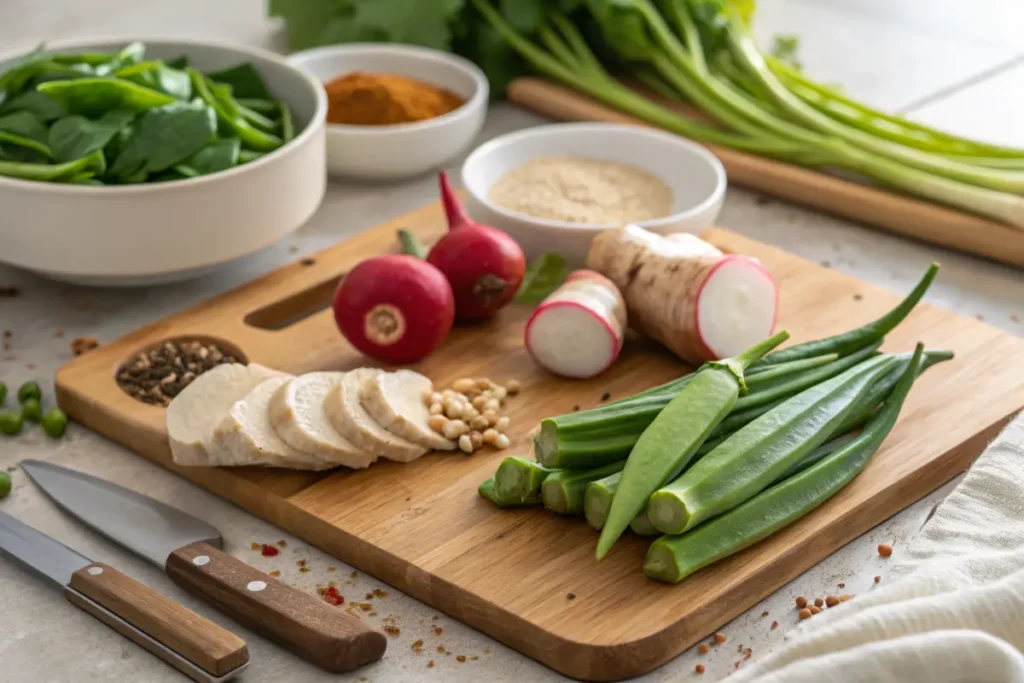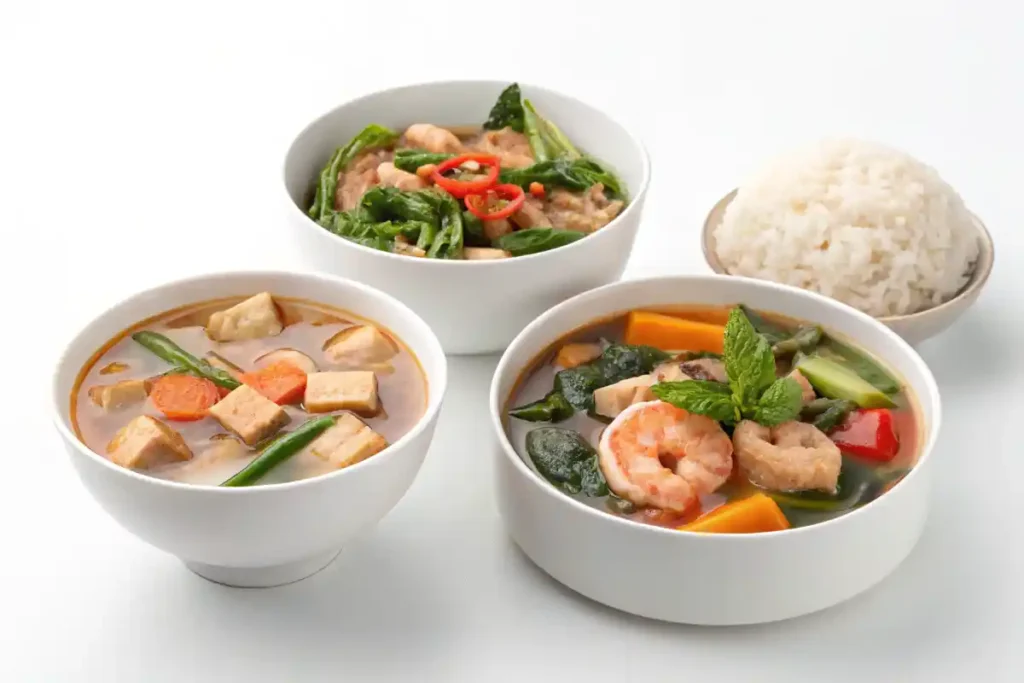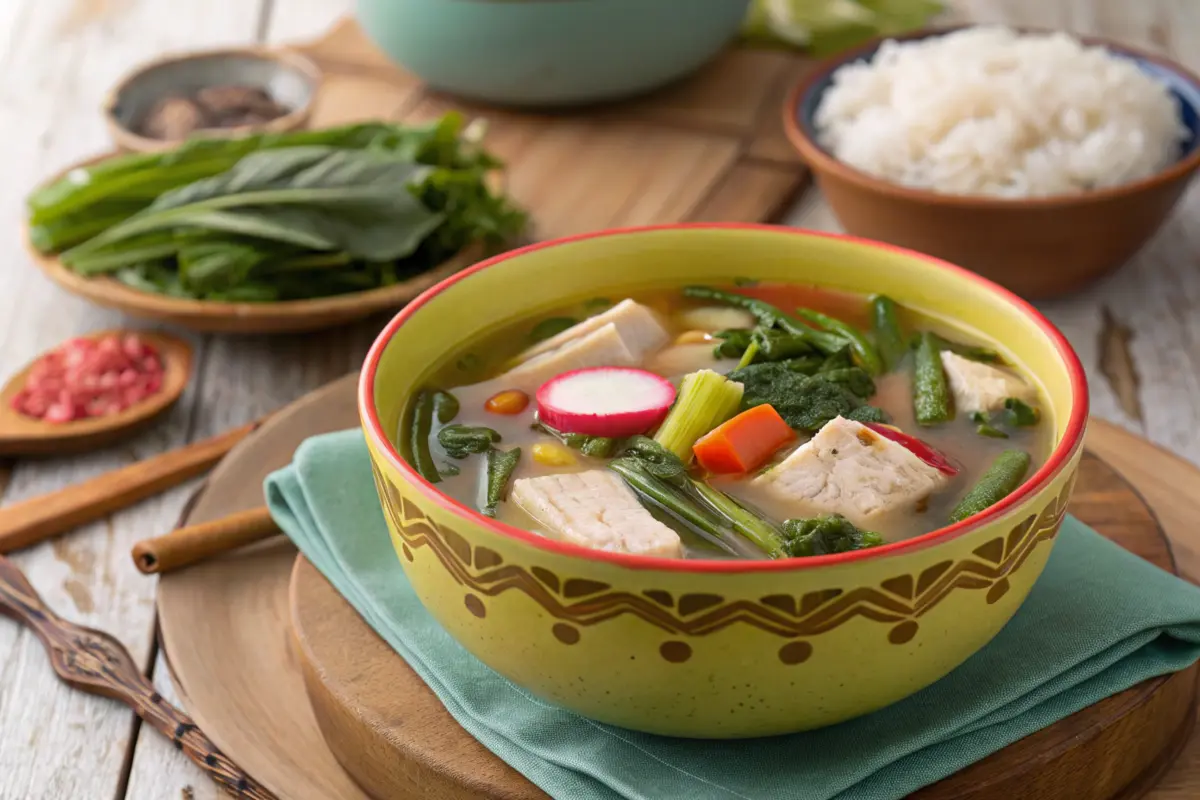Sinigang, a quintessential Filipino soup, is beloved not only for its tangy, comforting flavor but also for its potential health benefits. Packed with a medley of fresh vegetables, tamarind, and protein, this dish has earned its place in Filipino households as a go-to meal for nourishment and flavor. In this article, we’ll explore whether Filipino sinigang is healthy, delving into its nutritional value, health benefits, and even some potential concerns. We’ll also offer tips to make it even healthier while answering common questions surrounding this iconic dish.
Introduction to Sinigang
What is Sinigang?
Sinigang is a traditional Filipino soup known for its sour and savory flavor, achieved primarily through tamarind, though other souring agents like calamansi or green mango are also used. The dish typically includes a variety of vegetables—such as okra, eggplant, water spinach, and radish—and a choice of protein, often pork, shrimp, or fish. Sinigang’s unique flavor profile makes it a standout in Filipino cuisine.
The versatility of Sinigang is one of its most charming aspects. Whether you’re using seafood, chicken, or plant-based ingredients, the core essence remains the same: a comforting and tangy soup that’s perfect for any season.
Why Discuss Sinigang’s Health Aspects?
As more people seek healthier dietary choices, traditional dishes like Sinigang are being reevaluated for their nutritional benefits. But is Filipino Sinigang healthy? The answer lies in its ingredients and preparation. Packed with nutrient-rich vegetables and lean proteins, it can be a wholesome, well-balanced meal. However, concerns like sodium content or the use of fatty cuts of meat may affect its overall healthiness.
By understanding its nutritional profile, we can appreciate Sinigang not just for its flavor but also for its potential to contribute to a healthy lifestyle. And with some simple tweaks, this beloved dish can be made even healthier, making it an excellent addition to any diet.
Nutritional Profile of Sinigang

Key Ingredients in Sinigang and Their Nutritional Value
Sinigang’s diverse ingredients contribute to its rich nutritional profile. Vegetables, such as water spinach, radish, okra, and eggplant, are staples that pack a punch in vitamins and minerals. For instance, water spinach is a great source of iron and vitamin A, while radish offers dietary fiber and antioxidants. Okra, often praised for its gut-friendly benefits, adds more fiber, aiding digestion.
The star souring agent, tamarind, is not just for flavor—it’s a powerhouse of vitamin C, aiding in immune support and combating inflammation. Beyond tamarind, some variations use green mangoes or calamansi, both of which add unique flavors and health benefits.
Protein Sources in Sinigang
Depending on the recipe, Sinigang typically features proteins like pork, shrimp, or fish. Pork, when lean cuts are chosen, offers a healthy dose of protein and essential B vitamins. Shrimp is low in calories yet rich in iodine, while fish—particularly milkfish or tilapia—provides omega-3 fatty acids that promote heart health. These protein choices make Sinigang a versatile dish that can fit a range of dietary preferences.
To enhance the healthiness of Sinigang, consider swapping fatty cuts of pork with leaner options or using plant-based proteins like tofu for a vegetarian-friendly version.
Health Benefits of Sinigang
Rich in Vitamins and Minerals
The Filipino dish Sinigang is a nutrient-rich meal thanks to its fresh, natural ingredients. The variety of vegetables provides essential vitamins like A, C, and K, as well as potassium and magnesium. These nutrients are vital for maintaining a robust immune system, healthy bones, and stable blood pressure. Tamarind’s high vitamin C content further boosts immunity and supports collagen production for skin health.
Low in Calories and High in Fiber
Sinigang is surprisingly low in calories, especially when prepared with more vegetables and lean proteins. The high fiber content from vegetables like okra and radish helps with digestion and promotes satiety, making it a great choice for those managing their weight.
Immunity-Boosting Properties
Beyond its vitamins, Sinigang contains antioxidants from vegetables and tamarind, which help neutralize free radicals in the body. These properties make it not only comforting but also beneficial during cold and flu seasons.
For more ideas on optimizing your Sinigang recipe, check out this guide to Sinigang ingredients. It provides detailed insights into choosing the freshest, most nutritious components for your next meal.
Potential Health Concerns

Sodium Levels in Sinigang
While Filipino Sinigang is generally considered healthy, its sodium content can be a concern. Many recipes use commercial Sinigang seasoning mixes to enhance flavor, but these often contain high amounts of sodium. Excessive sodium intake is linked to high blood pressure and heart disease. Opting for homemade broth or low-sodium alternatives can significantly reduce this risk.
Adding fresh herbs, like lemongrass or ginger, is a simple way to amplify flavor without relying on salt-heavy seasonings. For a more natural approach, you can balance tamarind’s tangy flavor with fresh spices and aromatics.
Fat Content in Protein Sources
The choice of protein also plays a significant role in determining whether Sinigang is healthy. Pork belly, for example, adds a rich flavor but also contributes a significant amount of fat, including saturated fat, which can affect cholesterol levels if consumed frequently. Using leaner cuts, like pork tenderloin, or substituting with fish or tofu, can make the dish more heart-friendly.
When cooking Sinigang, consider using grilling or steaming methods for your protein before adding it to the soup. This approach helps reduce excess fat while retaining the dish’s essential flavor.
Tips to Make Sinigang Healthier

Using Fresh Ingredients
One of the easiest ways to ensure Filipino Sinigang remains healthy is by using fresh, natural ingredients. Fresh tamarind pods, vegetables, and herbs provide better nutrition and flavor than processed or pre-packaged options. Locally sourced produce is often fresher and retains more of its nutrients.
Low-Sodium Alternatives
As mentioned earlier, reducing sodium is key to making Sinigang healthier. Homemade broth from boiled bones and fresh vegetables can replace store-bought seasonings. Additionally, experimenting with spices like black pepper, chili, or fresh herbs can deliver bold flavors without relying on salt.
For more tips on preparing low-sodium dishes, visit our collection of healthy recipes on RecipeFoodies. This guide offers creative ways to maintain flavor while cutting down on unhealthy additives.
Protein Choices and Cooking Methods
Selecting the right protein can make a big difference in how healthy your Sinigang is. Opt for lean meats, fish, or even plant-based proteins like tofu or tempeh. Additionally, slow cooking or simmering your ingredients locks in nutrients and reduces the need for added fats or oils.
For more delicious, health-conscious recipes, explore our recipe suggestions on the RecipeFoodies site. They offer plenty of ideas for balancing flavor and nutrition in everyday cooking.
FAQs About Sinigang
Is Sinigang Suitable for a Weight Loss Diet?
Yes, Sinigang can be an excellent choice for weight loss, especially when made with lean proteins and a variety of fresh vegetables. Its high fiber content from vegetables like okra and water spinach helps keep you full longer, reducing the chances of overeating. Additionally, the broth-based nature of Sinigang makes it lower in calories compared to creamy soups, making it a lighter meal option.
However, if you’re asking, Is Filipino Sinigang healthy?, keep an eye on the sodium content. Opt for low-sodium seasonings or make your own broth to ensure it stays weight-loss friendly.
Can Sinigang Be Made Vegan or Vegetarian?
Absolutely! Sinigang is incredibly versatile and can easily be adapted into a vegan or vegetarian dish. Replace meat with plant-based proteins like tofu or tempeh, and load up on nutrient-dense vegetables such as mushrooms, eggplant, and kangkong (water spinach). You can also use vegetable broth and tamarind for a flavorful, meat-free version.
For those seeking a wholesome, vegan-friendly meal, Sinigang offers a satisfying and nutritious option that retains its signature tangy taste.
What Are the Best Pairings with Sinigang for a Healthy Meal?
Pair Sinigang with a side of brown rice or quinoa for added fiber and a complete meal. If you want to keep it low-carb, steamed vegetables or a small portion of grilled fish can make for a balanced plate. These options enhance the nutritional profile of the meal while keeping it light and healthy.
Conclusion
Summarizing the Health Aspects of Sinigang
So, is Filipino Sinigang healthy? The answer largely depends on how it is prepared. When made with fresh vegetables, lean proteins, and minimal sodium, Sinigang is undeniably a nutrient-packed and wholesome dish. Its tangy tamarind base and broth-centric nature make it a comforting yet health-conscious option for any meal.
From its rich vitamin content to its low-calorie profile, Sinigang offers numerous benefits. However, to maximize its health potential, it’s crucial to choose the right ingredients and avoid processed seasonings or fatty cuts of meat.
Encouraging Balanced Consumption
Incorporating Sinigang into your diet is a flavorful way to enjoy Filipino cuisine without compromising your health goals. By making thoughtful ingredient choices and balancing it with other healthy dishes, you can relish this traditional favorite as part of a balanced lifestyle.
Whether you’re trying to lose weight, boost your immunity, or simply enjoy a hearty meal, Sinigang checks all the boxes. Its versatility and adaptability mean there’s a version for everyone—healthy, delicious, and uniquely Filipino.
Cultural Significance of Sinigang
Sinigang as a Reflection of Filipino Heritage
Sinigang is more than just a dish; it’s a representation of Filipino culture and heritage. Known for its tangy and savory flavor, it symbolizes the Filipino love for bold and comforting meals. Shared at family gatherings and festive occasions, Sinigang often serves as a centerpiece, bringing people together over its hearty warmth.
As the question arises, Is Filipino Sinigang healthy?, it’s important to see how its ingredients also reflect Filipino values—using fresh, locally sourced vegetables and seasonings to create a nutritious, budget-friendly dish. Every region in the Philippines has its own variation, showcasing how the dish evolves while staying true to its roots.
How Sinigang Fits Into Modern Lifestyles
In today’s health-conscious world, Sinigang remains a go-to meal for those seeking comfort food without excess calories. It’s a dish that bridges tradition with modern nutritional needs. Many households now adapt Sinigang recipes to fit dietary restrictions, incorporating vegan ingredients or experimenting with low-sodium versions.
The versatility of Sinigang ensures it retains its place in Filipino kitchens, proving that a traditional dish can evolve to meet contemporary lifestyles without losing its identity.
Sinigang in Global Cuisine
Gaining Popularity Beyond the Philippines
As Filipino cuisine gains global recognition, Sinigang has emerged as a standout dish. Its unique balance of sour and savory flavors intrigues food lovers worldwide, making it a favorite in Filipino restaurants abroad. The increasing awareness of its health benefits also sparks interest, leading many to ask, Is Filipino Sinigang healthy?
Cooks in international kitchens are now putting their spin on the dish, substituting local produce or proteins while keeping the essential tamarind base intact. These adaptations highlight Sinigang’s versatility and universal appeal.
Sinigang as a Healthy Alternative to Other Soups
Compared to other popular soups like French onion or clam chowder, Sinigang stands out as a lighter and healthier option. Its clear broth, fresh vegetables, and lean protein choices make it an excellent alternative for those seeking nutritious, hearty meals. Moreover, its low-fat content and rich vitamin profile cater to health-conscious diners.
With its expanding presence in international menus, Sinigang continues to show that Filipino cuisine is not only delicious but also nutritious. Its global rise cements its place as both a cultural icon and a dish that aligns with modern health trends.

